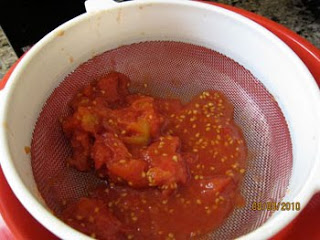Growing up, even the smallest dinner party was an affair worthy of some serious preparation. The house was scoured and scrubbed, and food preparations began two days before. I am not talking about holidays where we hosted thirty relatives. That was serious. That might have to be another blog post. I am talking about smaller dinner parties. Until the guest (or guests) actually arrived, it seemed like a rather stressful event. Don't get me wrong, I loved the dinner parties and holidays for that matter. So I figured out early that if I could make them less of an arduous task then I could probably have them more often.
Sure it's a weeknight. And maybe, just maybe, my apartment isn't perfectly in order. The floors aren't freshly mopped and the tiles aren't recently scrubbed clean. That being said, perhaps there also some shortcuts to my gourmet dinner. This week I did have two friends over for dinner who had not been to my apartment before which means, of course, that they haven't tasted my cooking. I certainly don't want to disappoint.
It was important to me that I was not busy with food preparations while they were visiting. As a gracious hostess, I wanted to spend time with my guests. So I devised a menu where most of the preparations could be done the night before.
Appetizer: Baked Brie with Fig Jam Wrapped in Puff Pastry
Start with good quality bacon,
This was all prepared the night before. So you can pop this in the oven 10 to 20 minutes before your guests arrive. It will bake about 15 to 20 at 400 degrees.
 |
| Sliced apples or pears are a nice pairing with this. |
 |
| Cut the brie through the center. If you can, use a knife that has a hollow, center blade for cheese. |
 |
| Add a generous layer of fig jam in the center. |
I definitely cheated for this part. I am hereby apologizing to all the foodie gurus who are reading this but, yes, that is store-bought puff pastry. If you are a greater home chef than I am you will have your own homemade version in your freezer. So, by all means use that. I am an imperfect foodie.
 |
| Just out of the oven! |
Main Course: Coq Au Vin
This is my slow cooker version of the classic. Here you want to do the prep work the night before and then dump your bowl of ingredients in your crock pot before leaving for work.
Start with good quality bacon,
Chop the bacon into pieces and fry it in a skillet with a little butter. I know, I know... but it probably wouldn't be a french dish if you didn't add butter. (I would say about four thinly sliced bacon strips to a whole chicken.) When the bacon is crispy set aside on a paper towel. Leave the bacon drippings in the pan. This is not a light meal after all.
Brown your cut up chicken in the same pan with the bacon fat (make sure you season your chicken with salt and pepper first). You don't want to cook it through because it is going in the slow cooker. You just want some good color and to seal in the juices. Then set the chicken aside, at this point maybe in a large bowl with the bacon. You will end up having all your ingredients in the same bowl. That way you can reach for in the morning when you are ready to put them in the slow cooker.
Now add your aromatics to the same skillet. I used chopped carrots, onion and garlic. Let that cook until they are soft. Then sprinkle with flour, stir for one more minute. Add a good red wine and bring to a boil. I used about three fourths of a bottle of wine. Once it reaches its boiling point, bring the heat down to a simmer. How long you want it to simmer depends on how much you want the sauce to reduce. Essentially, it depends on how thick you want your stew. Then add that to your bowl with the chicken parts and bacon.
Dump your bowl full of cooked ingredients into the crock pot the next morning. Add chopped button mushrooms, sprigs of thyme and a little extra salt and freshly ground pepper. Turn your crock pot on low and you're off.
Serve as is or over egg noodles. I served a very simple salad of pears, red lettuce and almonds, to accompany this dish because it is so rich.
Dessert: Framboise Lambic Ice Cream Floats
So I learned this cheat trick at a the home of a friend of mine. This dessert is so easy it's pretty self explanatory. Vanilla ice cream goes in the glass. Pour Framboise Lambic (raspberry, Belgian beer) over it. Done. You will be surprised how good this is.
An ice cream float toast to dinners at home with friends!




































